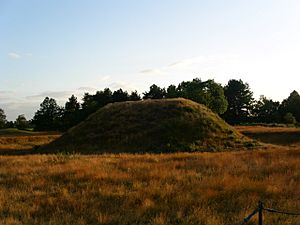Archaeology of Anglo-Saxon England facts for kids
The archaeology of Anglo-Saxon England is the study of ancient objects and places from England between the 400s AD and the 1000s AD. This was a time when Germanic tribes, known as the Anglo-Saxons, ruled the land. Archaeologists dig up and study these remains to learn about how people lived back then.
Contents
Discovering the Past
The Anglo-Saxon period lasted from about 410 AD to 1066 AD. This was when the Anglo-Saxons were the main group in England. Serious archaeological digs of Anglo-Saxon burial sites and towns started in the 1920s. Since then, these digs have taught us a lot about their society and culture.
One of the first people to understand Anglo-Saxon burials was Reverend James Douglas. He wrote about his discoveries in a book called Nenia Britannica in 1793. In the 1800s, more people became interested. Scholars like Thomas Bateman and Thomas Rickman wrote important books about Anglo-Saxon finds.
Anglo-Saxon Buildings
Anglo-Saxon buildings were mostly rectangular and made of wood. These included houses and large halls. Later, in the late 900s and 1000s AD, people started building more stone defenses and monuments. However, buildings in towns were still mostly made of timber.
Art and Shiny Things
Anglo-Saxon art is famous for its amazing metalwork and jewelry. They also made beautiful carvings and illuminated manuscripts (books with decorated pages). Their art was inspired by Germanic art and Celtic art. They also got ideas from places like the Mediterranean and early Christian Ireland.
In December 2019, archaeologists found Roman and Anglo-Saxon items near Baginton. These included pottery, jugs, and jewelry from burial grounds. The team believed two graves belonged to an important officer and a Roman girl. The girl's grave had four brooches, a ring with a cicada (a type of insect), and a hair pin.
In August 2021, archaeologists from the University of Reading found an old monastery at Cookham in Berkshire. It dated back to the time of Queen Cynethryth. They also found food remains, cooking pots, a bronze bracelet, and a dress pin.
How They Buried Their Dead
One of the most interesting things about early Anglo-Saxon society is how they buried people. Archaeologists have dug up many burial sites. Famous ones include Sutton Hoo, Spong Hill, Prittlewell, Snape, and Walkington Wold. About 1200 Anglo-Saxon pagan cemeteries have been found.
There wasn't just one way to bury people. The Angles in the north often preferred cremation (burning the body). The Saxons in the south usually preferred inhumation (burying the body). But both methods were used all over England, sometimes even in the same cemetery. If a body was cremated, the ashes were usually put in a pot and buried. Sometimes, items called grave goods were buried with the ashes.
Free Anglo-Saxon men were often buried with at least one weapon. This could be a seax (a type of knife), a spear, a sword, or a shield. Rich people were buried with many valuable items. Sometimes, animal skulls, especially from oxen or pigs, were buried in human graves. This was also a practice in earlier Roman Britain.
Later, in the 500s and 600s, burial mounds (large piles of earth over graves) started to appear. Sometimes, Anglo-Saxons even reused older mounds from the Neolithic, Bronze Age, Iron Age, or Romano-British times. We don't know why they started this, but it might have been from the native Britons. Even after Christianity arrived, burial mounds were still respected. Many churches were built next to them.
Another type of burial was ship burials. Many Germanic people across northern Europe did this. Often, the body was placed in a ship. The ship was then either sent out to sea or left on land and set on fire. But in Suffolk, ships were not burned. Instead, they were buried, like at Sutton Hoo. This site is thought to be the resting place of Rædwald, a king of the East Angles. Both ship and mound burials are described in the famous Beowulf poem.
Archaeologists have also found bodies where the head was separated from the body. For example, at a large burial site in Thetford, Norfolk, fifty individuals were found without their heads. Their heads might have been taken as war trophies. In other cases, this might have been part of a ritual or a punishment.
In September 2020, archaeologists found an Anglo-Saxon cemetery from the Sutton Hoo era in Oulton, near Lowestoft. It had 17 cremations and 191 burials from the 600s. The graves held the remains of men, women, and children. They also found items like small iron knives, silver pennies, wrist clasps, and strings of amber and glass beads. The soil was very acidic, so the skeletons had mostly turned into brittle shapes or "sand silhouettes."
In September 2021, archaeologists found the remains of St. Mary's Old Church near Stoke Mandeville. This church dates back to 1080. They found flint walls forming a square shape, surrounded by a circular border and burials. This discovery happened while they were working on the HS2 railway route.
Famous Dig Sites
- Sutton Hoo
- West Stow Anglo-Saxon Village
- Yeavering
- Taplow Barrow
- Mucking (archaeological site)
- Prittlewell royal Anglo-Saxon burial
- Walkington Wold burials
- Staffordshire Hoard
- Canterbury-St Martin's hoard
- Snape
See also


